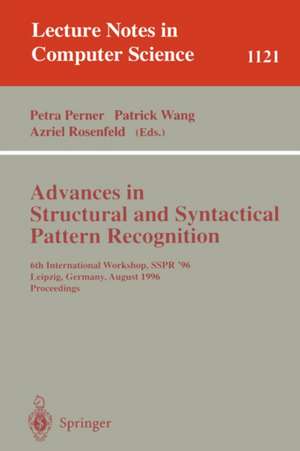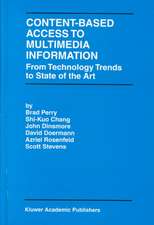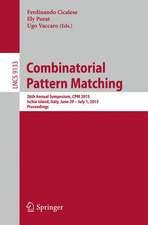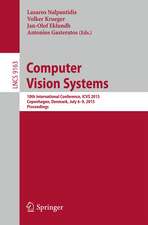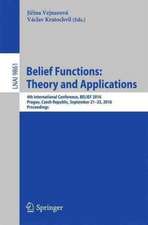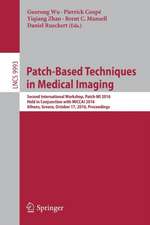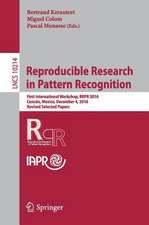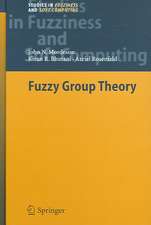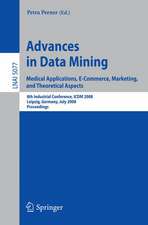Advances in Structural and Syntactical Pattern Recognition: 6th International Workshop, SSPR' 96, Leipzig, Germany, August, 20 - 23, 1996, Proceedings: Lecture Notes in Computer Science, cartea 1121
Editat de Petra Perner, Patrick Wang, Azriel Rosenfelden Limba Engleză Paperback – 7 aug 1996
The 36 revised full papers included together with three invited papers were carefully selected from a total of 52 submissions. The papers are organized in topical sections on grammars and languages; morphology and mathematical approaches to pattern recognition; semantic nets, relational models and graph-based methods; 2D and 3D shape recognition; document image analysis and recognition; and handwritten and printed character recognition.
Din seria Lecture Notes in Computer Science
- 20%
 Preț: 1061.55 lei
Preț: 1061.55 lei - 20%
 Preț: 341.95 lei
Preț: 341.95 lei - 20%
 Preț: 369.12 lei
Preț: 369.12 lei - 20%
 Preț: 645.28 lei
Preț: 645.28 lei - 20%
 Preț: 591.51 lei
Preț: 591.51 lei - 15%
 Preț: 580.46 lei
Preț: 580.46 lei -
 Preț: 410.88 lei
Preț: 410.88 lei - 20%
 Preț: 504.57 lei
Preț: 504.57 lei -
 Preț: 381.21 lei
Preț: 381.21 lei - 20%
 Preț: 340.32 lei
Preț: 340.32 lei - 20%
 Preț: 1414.79 lei
Preț: 1414.79 lei - 20%
 Preț: 538.29 lei
Preț: 538.29 lei - 20%
 Preț: 583.40 lei
Preț: 583.40 lei - 20%
 Preț: 1075.26 lei
Preț: 1075.26 lei - 20%
 Preț: 238.01 lei
Preț: 238.01 lei - 17%
 Preț: 360.19 lei
Preț: 360.19 lei - 20%
 Preț: 438.69 lei
Preț: 438.69 lei - 20%
 Preț: 1183.14 lei
Preț: 1183.14 lei - 20%
 Preț: 596.46 lei
Preț: 596.46 lei - 15%
 Preț: 438.59 lei
Preț: 438.59 lei - 20%
 Preț: 655.02 lei
Preț: 655.02 lei - 20%
 Preț: 649.49 lei
Preț: 649.49 lei - 20%
 Preț: 309.90 lei
Preț: 309.90 lei - 20%
 Preț: 337.00 lei
Preț: 337.00 lei -
 Preț: 449.57 lei
Preț: 449.57 lei - 20%
 Preț: 310.26 lei
Preț: 310.26 lei - 20%
 Preț: 1024.44 lei
Preț: 1024.44 lei - 20%
 Preț: 579.30 lei
Preț: 579.30 lei - 20%
 Preț: 763.23 lei
Preț: 763.23 lei - 20%
 Preț: 453.32 lei
Preț: 453.32 lei - 20%
 Preț: 575.48 lei
Preț: 575.48 lei - 20%
 Preț: 585.88 lei
Preț: 585.88 lei - 20%
 Preț: 326.98 lei
Preț: 326.98 lei - 20%
 Preț: 825.93 lei
Preț: 825.93 lei - 17%
 Preț: 427.22 lei
Preț: 427.22 lei - 20%
 Preț: 763.23 lei
Preț: 763.23 lei - 20%
 Preț: 350.21 lei
Preț: 350.21 lei - 20%
 Preț: 307.71 lei
Preț: 307.71 lei - 20%
 Preț: 580.93 lei
Preț: 580.93 lei - 20%
 Preț: 340.32 lei
Preț: 340.32 lei - 20%
 Preț: 343.62 lei
Preț: 343.62 lei - 20%
 Preț: 583.40 lei
Preț: 583.40 lei - 20%
 Preț: 583.40 lei
Preț: 583.40 lei -
 Preț: 389.48 lei
Preț: 389.48 lei - 20%
 Preț: 353.50 lei
Preț: 353.50 lei - 20%
 Preț: 607.39 lei
Preț: 607.39 lei
Preț: 338.16 lei
Preț vechi: 422.70 lei
-20% Nou
Puncte Express: 507
Preț estimativ în valută:
64.72€ • 67.32$ • 54.24£
64.72€ • 67.32$ • 54.24£
Carte tipărită la comandă
Livrare economică 13-27 martie
Preluare comenzi: 021 569.72.76
Specificații
ISBN-13: 9783540615774
ISBN-10: 3540615776
Pagini: 412
Ilustrații: X, 426 p.
Dimensiuni: 155 x 235 x 22 mm
Greutate: 0.58 kg
Ediția:1996
Editura: Springer Berlin, Heidelberg
Colecția Springer
Seria Lecture Notes in Computer Science
Locul publicării:Berlin, Heidelberg, Germany
ISBN-10: 3540615776
Pagini: 412
Ilustrații: X, 426 p.
Dimensiuni: 155 x 235 x 22 mm
Greutate: 0.58 kg
Ediția:1996
Editura: Springer Berlin, Heidelberg
Colecția Springer
Seria Lecture Notes in Computer Science
Locul publicării:Berlin, Heidelberg, Germany
Public țintă
ResearchCuprins
Efficient recognition of a class of context-sensitive languages described by Augmented Regular Expressions.- Optimal and information theoretic syntactic pattern recognition for traditional errors.- The morphic generator grammatical inference methodology and multilayer perceptrons: A hybrid approach to acoustic modeling.- Two different approaches for cost-efficient Viterbi parsing with error correction.- Bounded parallelism in array grammars used for character recognition.- Comparison between the Inside-Outside algorithm and the Viterbi algorithm for stochastic context-free grammars.- Generalized morphological operators applied to map-analysis.- Derivatives in scale space.- On skeletonization in 4D images.- Extended Cascade-Correlation for syntactic and structural pattern recognition.- A metric of planar self-similar forms.- Including geometry in graph representations: A quadratic-time graph isomorphism algorithm and its applications.- Hierarchical discrete relaxation.- Relational indexing.- An evidential merit function to guide search in a semantic network based image analysis system.- Inexact graph matching with genetic search.- Automatic recognition of bidimensional models learned by grammatical inference in outdoor scenes.- Signal decomposition with multiscale learning algorithms.- Structural learning of character patterns for on-line recognition of handwritten Japanese characters.- Recognition of hand-printed characters using induct machine learning.- Opponent color processing based on neural models.- Knowledge acquisition by symbolic decision tree induction for interpretation of digital images in radiology.- Invariants and fixed structures lead the way to change.- Representing shape by line patterns.- Recognition of 3D objects from 2D images — Some issues.- Surface skeletonization of volume objects.- Peculiarities of structural analysis of image contours under various orders of scanning.- A structural analysis of curve deformation by discontinuous transformations.- Three dimensional computer vision for computer aided design and manufacturing applications.- Using weighted minutiae for fingerprint identification.- Recognizing 2-D rigid and non-rigid wire-shapes.- Structural and syntactic methods in line drawing analysis: To which extent do they work?.- Vector-based segmentation of text connected to graphics in engineering drawings.- Automatic resolution of object features from engineering drawings for 3D reconstruction.- The feedback approach to cartographic areal text placement.- A hierarchical representation for the reference database of on-line Chinese character recognition.- Substructure shape analysis for Kanji character recognition.- Recognition of hand-printed Chinese characters using Ripple Down Rules.- A fuzzy syntactic method for on-line handwriting recognition.
